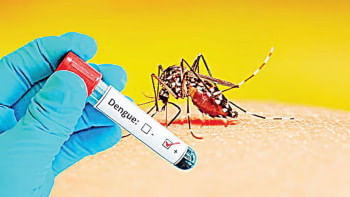Dengue surge: Delayed hospitalisation driving up fatalities

With five new dengue-related deaths reported yesterday, the nationwide death toll this year has climbed to 110, more than half of them from Dhaka South City Corporation (DSCC) areas.
According to the Directorate General of Health Services (DGHS), of the five latest deaths, three occurred in DSCC and two in Rajshahi division.

So far this year, 18 deaths have been reported from Barishal division, 17 from Chattogram, 11 from Dhaka North City Corporation, six from Rajshahi, five from Khulna, and one each from Mymensingh and areas of Dhaka outside the two city corporations.
Dr HM Nazmul Ahsan, associate professor at Shaheed Suhrawardy Medical College Hospital, identified delayed hospitalisation as one of the main reasons for the higher fatality rate this year.
"Although the number of dengue cases is slightly lower than in previous years, deaths are higher because people are paying less attention to dengue amid the presence of other viruses," he said.
For instance, out of 10 patients with viral fever, eight are currently found to have chikungunya and only two dengue. "Because of this, many patients do not take dengue seriously and reach hospitals late, often already in a critical stage," Dr Ahsan explained.
At present, four viral infections -- influenza, dengue, chikungunya, and Covid-19 -- are circulating in the country, according to medical experts.
"Many patients fail to recognise warning signs such as severe abdominal pain, difficulty breathing, bleeding, extreme fatigue, or a sharp drop in urination or platelet count. By the time they arrive at hospitals, their condition is often critical."
He recommended early admission for patients with comorbidities, elderly individuals, and pregnant women to reduce the risk of death. He also warned about the risks of cross-infection from different dengue serotypes, which can cause more severe outcomes if treatment is delayed.
Explaining why DSCC hospitals record the highest number of deaths, Dr Ahsan said many critically ill patients are referred from outside Dhaka to major hospitals in the city.
"When these patients arrive, their condition is often already critical. They are infected outside the capital but die in Dhaka hospitals, which may explain the higher death count reported here," he said.
He said delays in referral are another major factor. "A patient from Barishal or other distant districts may need five to six hours just to reach a Dhaka hospital and another hour for admission. If the patient is already in shock, this delay can be fatal," he said.
Dr Ahsan urged district-level hospitals to strictly follow the national dengue treatment guidelines and treat patients locally.
Public health expert Mushtaq Hussain echoed the call for earlier treatment and stronger local healthcare capacity.
He stressed the need to strengthen secondary care hospitals for vulnerable groups such as elderly patients, infants, and those with comorbidities, so they can be stabilised before being referred to tertiary hospitals.
Hussain also called for awareness campaigns to encourage people to use free dengue testing facilities offered by city corporations. He recommended expanding blood collection centres and secondary care facilities to ease pressure on medical college hospitals.
He emphasised the importance of year-round, community-driven cleaning efforts to control mosquito breeding.

 For all latest news, follow The Daily Star's Google News channel.
For all latest news, follow The Daily Star's Google News channel. 



Comments